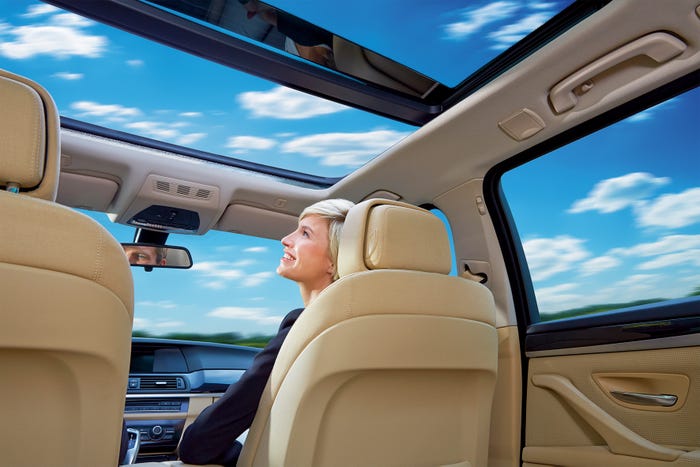How to Build a Better Automotive Skylight Sunroof System
Mammoth panoramic sunroofs transform the cabins of big cars, SUVs, and minivans by bathing rear seats in light and circulating air, so we've asked market leader Webasto to describe the latest developments.

Convertibles are stylish and fun, and thanks to developments in design and materials they have become more quiet and comfortable with the top raised than ever before. However, those of us who can’t fit a convertible into our lifestyles, so roof system suppliers like Webasto also have open-air sunroof products to indulge the rest of us in our practical minivans, SUVs, and sedans.
These vehicles‘ sunroofs have grown increasingly spacious and they transform the third-row area of vehicles from an unwelcoming space to an airy and comfortable place to spend time. Because of the advances occurring in this market, we thought it is a good time to ask Thomas Schuett, vice president of Advanced Engineering for the Webasto Group to discuss How to Build a Better Roof System. Webasto is the world market leader for selling carmakers roof systems.

Design News: What are the main challenges in designing and manufacturing modern roof systems?
Thomas Schuett: In order to develop high-quality roofs, the engineers work closely with the car manufacturers from the very beginning of the development of the roof system. This makes the best possible use of the short development times and the roofs can be better integrated into the overall vehicle. To meet the high quality and safety requirements, the roof systems are subjected to extensive testing.
Other challenges for roof systems are weight and space. To reduce the weight of the roofs, lightweight materials such as polycarbonate, paper honeycombs, and the specially developed Webasto Glas ProTec are used. To save space in the vehicle interior, space-saving drive units and roller blinds are installed.

DN: What are the main innovations you are seeing in these systems?
TS: One of the main innovations in roof systems is ambient lighting. With these light effects in the glass lid or along the guide rail, various light scenarios can be implemented: from illuminated patterns or printed glass or homogenous color gradients.
This creates a pleasant atmosphere in darkness while the glass element remains transparent by daylight. The switchable glazing is another innovation, which changes the light transmission of the roof element at the push of a button.
DN: How do you balance factors such as space, weight, and cost when developing a roof system?
TS: With almost 90 years of experience as a supplier to the automotive industry, we have the necessary know-how as well as market and trend knowledge. Due to our strong customer focus and close cooperation with the vehicle manufacturers from the start, we offer high quality and cost-efficient roof systems.

DN: What do customers like the most or find most exciting?
TS: In regular studies, we see a clear trend towards large panorama roofs. Customers appreciate a light-flooded vehicle interior and the possibility of fresh air without the draft through the open side windows or the annoying hum when the side window is only slightly open. We are also seeing a strong trend towards additional functions that increase the comfort for passengers, such as ambient lighting or switchable glazing.
DN: What is your favorite detail of a recent system that you’ve developed?
TS: One of my favorite features is the light graphic integrated into the roof element with ambient lighting. It generates a pleasantly soft atmosphere in the interior of the vehicle. The light graphic is printed on the glass element of the roof system. Printing creates a completely new design surface in the interior with great design freedom. The unobstructed view of the open sky remains unchanged.

DN: Is there a new trend in roof systems that will be interesting in the future?
TS: In the roof area, we offer a wide range of solutions for these mobility trends, too: A special highlight is the Roof Sensor Module, which we presented for the first time at the 2019 Frankfurt motor show - an openable roof system for autonomous vehicles. By using state-of-the-art, 3D moldable materials, the sensors as well as the associated cleaning systems and thermal management, can be integrated into the roof seamlessly. Further features such as ambient lighting and switchable glazing can also be integrated.
About the Author(s)
You May Also Like





